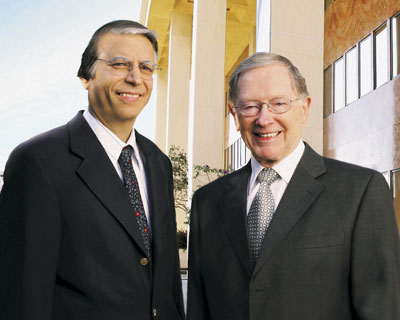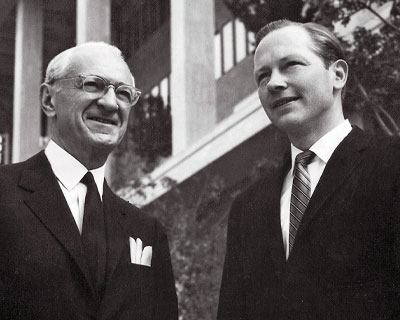Dr. Straatsma is a giant and legend in ophthalmology who led the University of California, Los Angeles (UCLA) into becoming one of the world’s premier centers for vision research, education, and patient care.

Bartly J. Mondino, MD and Bradley R. Straatsma, MD, JD, the only two chairs in ophthalmology at UCLA since 1966.
The son of a distinguished New York plastic surgeon, Dr. Straatsma was born in Grand Rapids, Mich. and obtained his undergraduate degree at the University of Michigan. He received his medical degree at the Yale School of Medicine, completed an internship at Yale and served in active duty as a lieutenant in the U.S. Naval Reserve. His ophthalmology residency was completed at the Harkness Eye Institute at Columbia University and was followed by two fellowships, one at the Armed Forces Institute of Pathology and the other at the Wilmer Eye Institute at Johns Hopkins University.
Dr. Straatsma was appointed to the UCLA faculty in 1959 as the first full-time chief of the division of ophthalmology. In 1961, Dr. Straatsma enlisted the support of Dr. Jules Stein –– a philanthropist, ophthalmologist, and founder of Music Corporation of America –– to establish the Jules Stein Eye Institute at UCLA, which opened its doors in 1966 and celebrated 50 years of achievement in 2016.

Jules Stein, MD and Bradley Straatsma, MD, JD
As founding director, Dr. Straatsma was responsible for the rapid growth of the institute and the associated department of ophthalmology. The institute and department have been consistently voted the best eye care center in the western United States in U.S. News & World Report since the rankings began. Recognizing that advances in excellence demanded growth in facilities, Dr. Straatsma presided over the dedication of the Doris Stein Eye Research Center in 1988.
Dr. Straatsma has authored more than 575 scientific publications on subjects, including vitreoretinal disease, choroidal melanoma, and ophthalmic education. He has presented more than 50 distinguished and named lectures and received over 75 honors and awards, including an honorary Doctor of Science degree from Columbia University, a Laureate award from the Academy and a Jules François Golden Medal from the International Council of Ophthalmology (ICO).
Dr. Straatsma has served in the highest leadership positions in both national and international ophthalmology, including as president of the American Academy of Ophthalmology and Otolaryngology, American Ophthalmological Society, Association of University Professors of Ophthalmology, Pan-American Association of Ophthalmology and Academia Ophthalmologica Internationalis (AOI). He has also served as chairman of the American Board of Ophthalmology.
In addition to noting Dr. Straatsma’s professional achievements, I would like to touch on his personal attributes. UCLA Clinical Committee meetings provided a valuable opportunity to watch Dr. Straatsma work through difficult and challenging situations, and his approach to leadership should be emulated widely. Dr. Straatsma was always calm and deliberate, and in the face of insurmountable opposition, he always returned with a better plan for ready adoption.
Both before and after his presidency, Dr. Straatsma has been heavily involved with the Academy. His relationship with the Academy began when Dr. Straatsma served as the first secretary for continuing education in ophthalmology. He and Dr. Bruce Spivey transformed the former home study course into the current ophthalmology Basic and Clinical Science Course™. Dr. Straatsma was the last person to serve as the president of the American Academy of Ophthalmology and Otolaryngology, and he presided over the difficult process of separating the organizations and incorporating the two individual academies: the American Academy of Ophthalmology and the American Academy of Otolaryngology.
In 1987, he edited, “Eye Care for the American People,” an invaluable document that provided the Academy with a blueprint to guide ophthalmologic care for the American public.
As editor-in-chief of the American Journal of Ophthalmology from 1993–2002, he revitalized the publication. He made substantial editorial innovations, strengthened the peer review process, enhanced the appearance of the journal, and introduced its website, ajo.com –– propelling the American Journal of Ophthalmology into the digital age.
After stepping down as chair of the UCLA Department of Ophthalmology and director of the Stein Eye Institute in 1994, Dr. Straatsma attended the University of West Los Angeles School of Law and received his juris doctor degree in 2002.
Dr. Straatsma is committed to globally advancing eye care. He co-chaired a joint meeting of the ICO and the AOI for global ophthalmology planning, and he was the primary author of the resulting “Vision for the Future –– International Ophthalmology Strategic Plan to Preserve and Restore Vision,” published in 2002. The strategic plan resulted in a formal curriculum for worldwide ophthalmology education of medical students, residents, and para-ophthalmic specialists, as well as a series of ophthalmology residency program director courses held throughout the world.
Dr. Straatsma is a trustee of the Africa Eye Foundation and was directly involved in establishment of the Magrabi ICO Cameroon Eye Institute at Yaoundé, Cameroon. The institute, which opened in 2016, serves to improve, preserve, and restore eye health and vision for the people of central Africa.
What people may not know about Dr. Straatsma is the importance that music has played in his life. He was an accomplished trombone and baritone saxhorn player, even performing as a soloist in national competitions. He was a member of the University of Michigan’s marching band, and he played in a concert band, a jazz band, and various ensembles throughout school.
In its early years, the medical school at UCLA had a faculty band that Dr. Straatsma joined upon his arrival to the university. The band would play at the nearby Bel Air Country Club, record their performances, and then play the recordings back to themselves as they ate dinner. Unfortunately, as far as anyone knows, those recordings have not survived after all these years. Eventually, with the pressures of academic life, performing fell by the wayside, and Dr. Straatsma never picked up his trombone again.

Dr. Straatsma and his wife Ruth
Nevertheless, music has remained an important part of his family’s life. Ruth, Dr. Straatsma’s wife of 65 years, was an accomplished musician and active supporter of the Los Angeles Philharmonic, and they were frequent attendees at the Los Angeles Music Center’s Disney Concert Hall. Music also created a bond between Dr. Straatsma and Dr. Jules Stein –– who was a jazz musician, and they shared many conversations about their mutual love of music.
Before joining the UCLA faculty, Dr. Straatsma served in the U.S. Navy as a physician for the Navy’s Underwater Demolition Team, the precursor to today’s Navy Seals. He became close with the “Navy frogmen” (as they called themselves at the time), with whom he served on submarines. With them, he learned to scuba dive long before it became a common recreational sport. Eventually, his entire family became certified scuba divers, and for years, he and Ruth would combine travel to medical conferences with dive trips throughout the world.
In closing, Dr. Straatsma’s character deserves comment. He is recognized for his honesty, integrity, and fairness. I have never known him to be harsh, abrasive or insulting to anyone. His calm demeanor was always evident no matter how difficult the circumstance. At an event celebrating his leadership at UCLA, I was asked to make comments about his career, and I stated that he was the “finest chair in ophthalmology.” I have no reason to change this statement.
Editor’s note: We are grateful to our History of Ophthalmology editor, Daniel M. Albert, MD, MS, and his editorial assistant, Jane Shull, who contributed to the editing of this article.